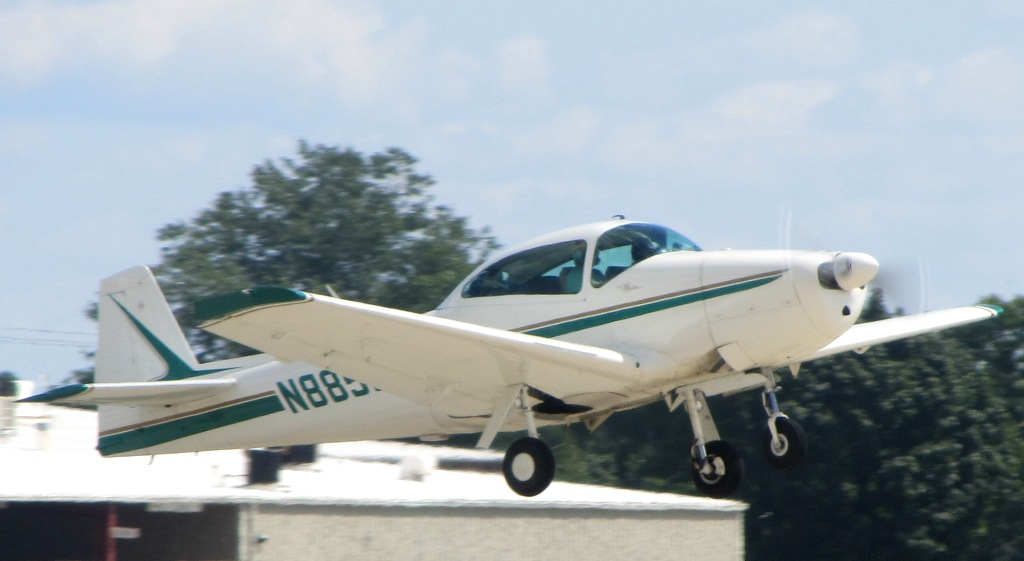In late August 1945, North American Aviation proposed the NA-143 light utility aircraft which featured a tricycle landing gear, simple aluminum construction, and seating accommodations for the pilot and three passengers, with power provided by one 185 hp (138 kW) Continental E185 flat piston engine. This design was christened the Navion, and the commercial production version proposed in January 1946 was designated NA-145 by the company. The rugged design of the Navion was tailored to match the intended post-World War II boom in US general aviation, and the assumption was that wartime pilots would come home and continue flying with their families and friends under peacetime conditions. Two NA-143 prototypes were built (NX18928 and NX18929), with the first prototype taking to the skies in April 1946. North American eventually produced 1,027 commercial Navions from 1946-1947 for light utility purposes, although the post-World War II boom in general aviation anticipated by North American did not materialize. The US Army Air Force took a keen interest in the Navion and in 1946 it placed an order for 83 aircraft (serial numbers 47-1297/1379) under the designation L-17A (company designation NA-154) for use a liaison and staff transport aircraft, The L-17A first flew in 1947, and 36 L-17As were given to the US Army while 47 were lent to the Air National Guard.
Even as the US military was taking deliveries of the Navion, North American Aviation handed over the Navion design to the Ryan Aeronautical Company in the summer of 1947 due to its growing focus on the AJ Savage and F-86 Sabre programs. Ryan launched production of the Navion in 1948, building 600 examples of the baseline Navion and eventually undertaking development of two improved Navion variants, the Navion A with one 205 hp (153 kW) Continental O-470-7 flat piston engine and the Navion B (also called the Super Navion 260) with by one 260 hp (194 kW) Lycoming GO-435-C2 geared flat piston engine. Ryan completed a total of 602 Navion A and 222 Navion B aircraft before ending production in 1951 to focus on unmanned air vehicle development, by which time it had built more than 1,400 Navions under license. The military designation L-17B was assigned to 163 Navion A airframes delivered to the US Army and ANG with serial numbers 48-921/1078 and 49-1961/1965, and 35 L-17As (47-1298/1301, 47-1303/1313, 47-1315/1319, 47-1321/1328 and 47-1335) were designated L-17C after being fitted by Ryan with improved brakes and fuel capacity; the L-17Bs with serials 49-1961/1965 were eventually delivered to the Royal Hellenic Air Force in Greece in the early 1950s). Three Navion Bs ordered by the US Army in 1950 with serial numbers 51-16425/16427 were originally designated XL-22 but were redesignated XL-17D before delivery. The L-17 augmented its liaison and staff transport duties with casualty evacuation and forward air control roles during the Korean War, aiding American and South Korean troops in preventing friendly fire incidents and evacuating US war casualties. The L-17s were retired from frontline service in 1957 and eventually handed over to the USAF's civil air patrols or used as hacks, by which time the Tulsa Manufacturing Corporation in Tulsa, Oklahoma, had converted many Navion airframes to Navion D, E, and F configuration with wingtip tanks and an inverted Continental IO-470H piston engine after acquiring development rights for the Navion. After US Defense Department established the Tri-Service aircraft designation system on September 18, 1962, the L-17s remaining in service were redesignated U-18, with L-17A, L-17B, and L-17C becoming U-18A, U-18B, and U-18C respectively.
The Navion airframe I saw at the Planes of Fame Museum back in 2019, despite sporting a military paint scheme, was actually not used by the US military. It was completed on October 31, 1946 and flew on December 7 (the fifth anniversary of the Pearl Harbor attack), bearing the civil registration N91161 and serving several civilian customers until it was donated to the Planes of Fame Museum in Chino, California, in 1996. The Planes of Fame Museum boss Steve Hinton found the aircraft to be in derelict shape and in 2003, two volunteers, Bill Fisher and Jury Vanderwoude, launched a project to restore N91161 to good condition. When Fisher died while the restoration was taking place, Vanderwoude emblazoned the aircraft's nose with the Li'l Bill nose art as a tribute to Fisher, and another volunteer joined the restoration project, painting the aircraft in the US Army color scheme applied to the L-17 variant of the Navion. After 20,000 hours of volunteer labor, the restoration of N91161 was completed in 2018, and the aircraft made its first post-restoration flight of N91161 on April 25, 2019, a little over a week after I saw the aircraft in person.
Nearly 70 years after its inception, the Navion is still in active use by private individuals, largely thanks to the purchase of the type certificat, design data, molds and tooling for the Navion by Sierra Hotel Aero Inc. of South St. Paul, Minnesota on March 18, 2003, and an active community of Navion owners. Although outside the scope of this blogpost, it must be mentioned that in January 2013 Sierra Hotel Aero announced plans to bring the Navion back into production, but it is unclear if this scheme has materialized.






